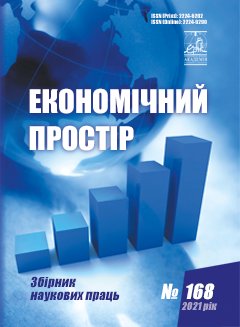AGENT-ORIENTED DIFFUSION MODEL IN INNOVATIVE CLUSTERS
Abstract
The current stage of development of the world economy is characterized by a gradual increase in the level of its intellectualization and the transition to an economy based on knowledge rather than material resources. The ability of the national economy to absorb knowledge and use it effectively will increasingly determine the economic strength of a nation and the well-being of its citizens. The key components of a knowledge-oriented economy are innovations and organizations that contribute to their creation and dissemination. Achieving and maintaining an advantage over competitors is facilitated not only by innovation and education, but also by forming effective relationships between enterprises, which provides the conditions for the creation of network structures - clusters. Diffusion model is one of the methods of the distribution process innovation research. The subject of the diffusion model is the idea of the level of prevalence of innovation among a certain set of potential consumers in terms of mathematical dependence on the time that has elapsed since the introduction of innovation. Today, the most well-known and popular theories of innovation are the diffusion models of Frank Bass and Everett Rogers. From the point of view of the agent-oriented model of diffusion, the buyers of innovation cluster products are autonomous agents who are guided by certain rules and differ not so much in their fixed assets and implemented technologies as in production and innovation strategies. Depending on the behavior of agents, the following types are selected: innovator agent, «early minority» agent, «early majority» agent, skeptic agent, conservative agent. The general scheme of perception of innovation in agent-oriented diffusion model of innovation clusters has a hierarchical form. The higher the level of knowledge and competence of the agent, the greater his propensity to innovate. Innovators are the first agents to embrace or acquire innovation. As a result, we got a model that shows the number of customers at the time of model time. The developed agent model of diffusion in innovation clusters can be used in marketing research and product pricing, taking into account consumer behavior according to the classification of E. Rogers.
References
Fourt, L.A., Woodlock, J.W. Early prediction of market success for new grocery products. Journal of Marketing. 1960. Vol 25. P. 31–38.
Bass F.A. New Product Growth for Model Consumer Durables. Management Science. 1969. V. 15(5). P. 215–227.
Rogers E.M. Diffusion of innovations (4th ed.). New York : The Free Press, 1995. 518 p.
Полтерович В.М., Хенкин Г.М. Эволюционная модель взаимодействия процессов создания и заимствования технологий. Экономика и математические методы. 1988. T. XXIV. Вып. 6. C. 1071–1083.
Mansfield, E. Technical change and the rate of imitation. Econometrica. 1961. № 29(4). P. 741–766.
Bass, Frank M., Trichy V. Krishnan, and Dipak C. Jain. 1994. Why the Bass Model Fits Without Decision Variables. Marketing Science 13, Summer. 203–223.
Евдокимов С.А. Перспективы развития региональных экономических моделей оценки диффузии инновационных товаров-комплементов. Регион в период модернизации: социальные институты : II Междунар. науч.-практ. конф. Нижний Новгород, 2013. С. 109–117.
Fourt L.A., Woodlock J.W. (1960) Early prediction of market success for new grocery products. Journal of Marketing vol. 25, pp. 31–38.
Bass F. (1969) A new product growth model for consumer durables. Management Science, vol. 15, no. 5, pp. 215-227.
Rogers E.M. (1995) Diffusions of Innovations, 4th ed. New York: The Free Press.
V.M. Polterovich and G.M. Khenkin (1988) Evolyucionnaya model' vzaimodejstviya processov sozdaniya i zaimstvovaniya tekhnologij [An evolutionary model of interaction between the processes of creating and borrowing technologies]. Economics and Mathematical Methods, vol. 14, no. 6, pp. 1071–1083.
Mansfield, E. (1961) Technical change and the rate of imitation. Econometrica vol. 29, no. 4, pp. 741–766.
Bass, Frank M., Trichy V. Krishnan, and Dipak C. Jain. (1994) Why the Bass Model Fits Without Decision Variables. Marketing Science 13, Summer, 203-223.
Evdokimov S.A. (2013) Perspektivy razvitiya regional'nyh ekonomicheskih modelej ocenki diffuzii innovacionnyh tovarov-komplementov. [Prospects for the development of regional economic models for assessing the diffusion of innovative complement goods]. Proceedings of the Region v period modernizacii: social'nye instituty. II mezhdunarodnoj nauchno-prakticheskoj konferenczii (Russia, Novgorod, 2013), pp. 109-117.



